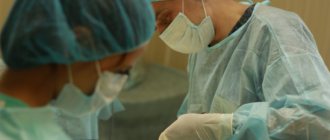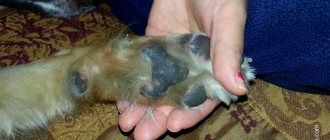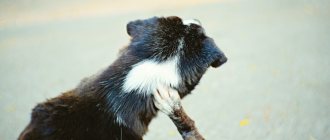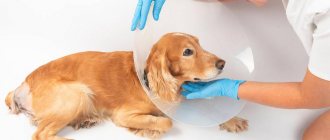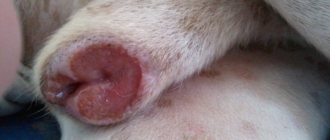Joint dysplasia is a non-fatal disease that is most often inherited from the parent pair to the puppies. This does not mean that every baby from the litter is born sick. The pathology may not manifest itself for several generations.
The disease is not only hereditary, but also acquired. The development of dysplasia is influenced by many factors; sometimes even healthy puppies show characteristic signs of the disease. And in potentially predisposed dogs, the characteristic symptoms of the pathology do not appear until the end of their lives.
What is meant by the term “dysplasia”
A joint is a movable hinge that facilitates the sliding of bones. It acts as a shock absorber, preventing abrasion and destruction of hard surfaces.
With abnormal development or under the influence of a number of unfavorable factors, the shape and size of one or more hinges undergo pathological changes. The gap between the bones and the articular cavity increases, worsening the tightness of the fit. Due to the uneven distribution of the load, dislocations, subluxations and inflammation occur.
Most often, pets under one year of age suffer from this disorder. Puppies are commonly diagnosed with hip dysplasia (HD). Anomalies in the elbows and knees are much less common.
Main causes of pathology
In most cases, the disease is transmitted genetically from parents. But it is important to note here that it is absent in newborns. This means that bad heredity is not a direct cause. It only increases the existing risks during the active growth phase.
Dogs born from completely healthy parents can also get sick. In such cases, dysplasia is explained by unfavorable external factors that affect the development of bone and cartilage tissue.
Breed genetic predisposition
The risk group includes representatives of large breeds: Rottweilers, Dogues de Bordeaux, German shepherds, St. Bernards, Alaskan Malamutes. Their musculoskeletal system does not always keep up with weight gain. Because of this, an unbearable load falls on the paws that are not fully strengthened.
Adverse external factors
The disease is less common in pugs, French bulldogs and other small breeds. In their case, the cause is the following factors:
- low quality diet (cheap feed and questionable products);
- surplus or deficiency of animal protein, phosphorus or calcium;
- obesity;
- hormonal imbalances;
- paw injuries;
- excessive loads.
Mistakes made in the care and maintenance of puppies affect their health for 1.5 years from the moment of birth. The age at which symptoms first appear depends on the severity and type of the disease.
Age of onset of symptoms and their description
Noticeable signs appear at 1-1.5 years, but by this time the prognosis for the animal is disappointing. The diagnosis can be made earlier (at 4-7 months), but only with regular examination by a veterinarian. For this reason, it is recommended that dogs at risk undergo CT scans and x-rays for preventive purposes. This is the only way they can avoid complications such as osteoarthritis and paralysis.
For pathology of the hip joints
The disease is asymptomatic for a long time, complicating timely diagnosis. Most often, concerned owners consult a doctor when they experience pain in their hind legs. It can be easily identified by:
- refusal to climb stairs or jump on a sofa or into a car;
- discomfort that occurs even while sitting (the animal has difficulty changing positions);
- wagging the croup and relying on the forelimbs;
- lameness in one or both hind legs, worse after waking up;
- aggression shown by any attempt to touch the back of the body.
Signs and symptoms of hip dysplasia in dogs often appear with a long delay. This is explained by the chronic course of the disease and gradual adaptation to a mild pain syndrome.
For pathology of the knee joints
A rare form that develops after a knee injury. It differs from the previous one in the sudden onset of an acute attack of pain and ongoing discomfort even during sleep. The affected joints become deformed, causing noticeable lameness in the hind legs.
For pathology of the elbow joints
The only type of pathology when lameness occurs in the forelimbs. The dog avoids not ups, but downs. When walking on a hilly area, he will try to slide down the hill without moving his paws.
At an advanced stage, lumps appear on the elbows, and the sick pet takes very strange positions while sleeping. His forelimbs move in different directions, since bending them under himself causes very severe pain. Any unfortunate touch from the owner causes similar discomfort.
How is the diagnosis carried out?
It is quite possible to distinguish hip dysplasia in a dog from less common varieties, but the final diagnosis must still be made by a doctor. In addition to the type of pathology, it is necessary to find out the stage of its development. The subsequent method of treatment and the prognosis for recovery depend on this.
Ortolani and Bardens tests
To determine abnormal mobility, the four-legged patient is put into medicated sleep and placed on its side. The manipulations performed by the veterinarian depend on the type of test:
- Teats Ortolani.
The doctor presses on the sore paw, causing it to subluxate. After this, he moves the limb to the side so that the joint returns to its place. The pathology is confirmed when the femoral head moves freely into place. This test also determines the condition of the femur. If its integrity is preserved, the last action is accompanied by a characteristic click, and if there is deformation, this sound is absent.
- Bardens test
. The paw being examined is raised up, and the thigh is grabbed with the right hand and shifted 45-60°. This action, like the previous one, provokes prolapse of the femoral head. During manipulations, the index finger of the doctor’s left hand rests on the greater trochanter. This tubercle connects the femur to the pelvis. In the presence of dysplasia, it moves to the side.
Both orthopedic tests are recommended for dogs under 1 year of age. After this age, 50% of results are false negative.
Other studies
In addition to tests and a general examination, including palpation and flexion-extension of the limbs, the four-legged patient will need to take a blood test and undergo an X-ray or computed tomography (CT) scan.
The first study is carried out only after reaching 7 months. Before this age, images do not show the full picture, so the diagnosis is confirmed only by the volumetric projection of a CT scan.
The most informative study is arthroscopy. When it is carried out, 2 incisions are made on the thigh to insert an endoscope, which produces an image in real time. Despite its advantages, this method is very expensive and is available in a limited number of veterinary clinics.
Definition of disease
You should not determine the presence or absence of the disease on your own; this serious matter must be entrusted to professionals.
The veterinarian will determine the presence of the disease using the following measures:
- — visual inspection of the dog and testing for joint mobility (flexion, extension);
- — the doctor will take an x-ray of the dog, which is carried out under anesthesia so that the dog lies still. Using x-rays I determine the extent of the disease;
- - arthroscopy (examination of the joint cavity), with the help of which a lot of information is obtained.
IMPORTANT! This procedure is very expensive, so it is performed only in large hospitals.
After carrying out all the above procedures, the veterinarian will prescribe the necessary treatment for the pet depending on the degree of the disease.
Conservative treatment methods
It is impossible to completely recover from pathology using conservative methods, but with their help you can slow down the development of the disease. With stable remission and proper care, the average life expectancy characteristic of the breed of the sick animal can be preserved.
Conservative treatment of dysplasia in dogs is based on taking medications, attending physical procedures and using compresses. All these measures are effective only at an early stage.
Drug therapy
The medications prescribed by your doctor will have to be taken for life. These include:
- chondroprotectors that restore joint tissue;
- anti-inflammatory or glucocorticosteroids that relieve inflammation;
- antispasmodics and analgesics that eliminate spasms and pain.
In addition to the listed medications, vitamin and mineral complexes with chondroitin and glucosamine are used. These dietary supplements normalize limb mobility, strengthen ligaments, stimulate metabolic processes and improve tissue regeneration.
Physiotherapy
Non-surgical treatment of hip dysplasia in dogs is not complete without physiotherapy. These include:
- magnetic laser therapy;
- electrophoresis;
- ozokerite treatment;
- acupuncture;
- paraffin therapy;
- paw massage
All of these procedures are aimed at reducing pain, eliminating inflammation and strengthening joint tissue. In addition, veterinarians recommend signing up for swimming or therapeutic exercises.
Compresses
Traditional medicine is ineffective, so it should be used only as part of complex therapy. Baths with medicinal herbs, compresses of boiled potatoes and cabbage leaves with honey will help relieve pain.
Surgery
Hip dysplasia in dogs can only be completely eliminated through surgery. It is recommended for almost all four-legged patients, except for the elderly or those who are too large. In the first case, the risk is associated with anesthesia, and in the second, with the complexity of the intervention due to the impressive size of the animal.
Osteotomy and juvenile symphysiodesis
Osteotomy is an operation aimed at eliminating the resulting deformity by introducing a special plate into the articular notch. Thanks to it, it is possible to restore the natural shape of the joint and prevent new prolapses. It is carried out after reaching 6-7 months in the initial stages of dysplasia, provided there is no arthritis.
For patients younger than 5 months, juvenile symphysiodesis is recommended. This surgery slows the growth rate of the pubic bones, which often leads to prolapse of the femoral head. Thanks to symphysiodesis, it is possible to maintain the natural density of the bones and prevent the development of the disease even before it appears. This treatment method is minimally invasive, does not require long rehabilitation and is used for dogs at risk.
Arthroplasty
A more complex operation recommended for arthrosis and requiring a long recovery. During the procedure, the dog's femoral head is removed and the joint capsule is sutured. Friction of hard surfaces is prevented by a pad formed from the gluteal muscle.
Prosthetics
If taking medications does not bring the desired effect, then dogs weighing more than 20 kg are prescribed prosthetics. The damaged area is replaced with a titanium prosthesis, which fully restores motor activity after rehabilitation. In addition to the complexity of the procedure, the disadvantages of this operation include its cost. On average it is 50-120 thousand rubles.
Prevention
If a dog has a predisposition to dysplasia due to family ties with sick dogs or this is a feature of the breed, then it is necessary to examine the pet at an early age. The first X-ray examination is carried out at 5-6 months, and repeated a year or a little later. At the same time, it is important to constantly pay attention to the pet’s behavior, its walking, running, and paw placement. At the slightest suspicion, you should contact a veterinary clinic.
Normalized physical activity and a balanced diet will benefit your pet in any case, even if the likelihood of illness is minimal.
Features of nutrition of a sick animal
Most pets with dysplasia suffer from obesity, so they must be put on a low-calorie diet with a weekly fasting day. When reviewing your current diet, you must:
- Give up economy-class dry food or improve the quality of natural products.
- Exclude prohibited foods from the menu (sweets, smoked foods, pickles, canned food, flour).
- Make sure you have adequate protein intake.
- Reduce your usual portions of food to smaller amounts that allow you to lose excess weight.
With natural feeding, it is recommended to introduce dietary supplements into the diet, and with dry feeding, choose veterinary food with chondroprotectors.
Dog care
It is very important to ensure that the dog is in a state of rest during THD and DLS, so that it avoids sharp turns and twisting. The regime is limited to walks on a leash, and their duration is determined by the condition of the pet (after which the dog should not limp). It is also necessary to normalize the diet, avoiding overfeeding the dog. If you feed dry food, it can be replaced with special medicated food to maintain healthy joints. Annual follow-up with an orthopedic surgeon is required.
Prognosis for recovery and future life
Prognosis for recovery directly depends on the degree of hip dysplasia diagnosed in the dog:
A.
A physiological norm that excludes the presence of violations.
IN
. The diagnosis is suspicious. The animal requires regular examinations, proper nutrition and adequate exercise.
WITH.
Mild degree with minor impairments. Without compliance with prevention and conservative treatment, periodic dislocations are possible, so the pet’s condition must be monitored.
D
. Pathology of moderate severity, characterized by rapid development. The method of treatment is selected individually.
E.
An advanced form of the disease, accompanied by constant excruciating pain and loss of motor function. Treatment is strictly surgical, since taking medications gives only a temporary effect.
Most often, owners seek help at the third stage (C), when the dog develops characteristic pain at the site of inflammation. The prognosis up to the fourth stage (D) is positive. If all recommendations are followed, a sick pet can live more than 10 years.
Briefly about the main thing
- Dysplasia is not just one disease of any organ. This pathology can occur anywhere in the body.
- The cause of dysplasia is most often heredity, so it is important to carefully select a puppy and evaluate its pedigree.
- Key factors that can influence the development of THD are nutrition, growth rate, injury/stress.
- It is impossible to cure dysplasia, you can only stop the development of diseases associated with this pathology. The best treatment method is surgery.
